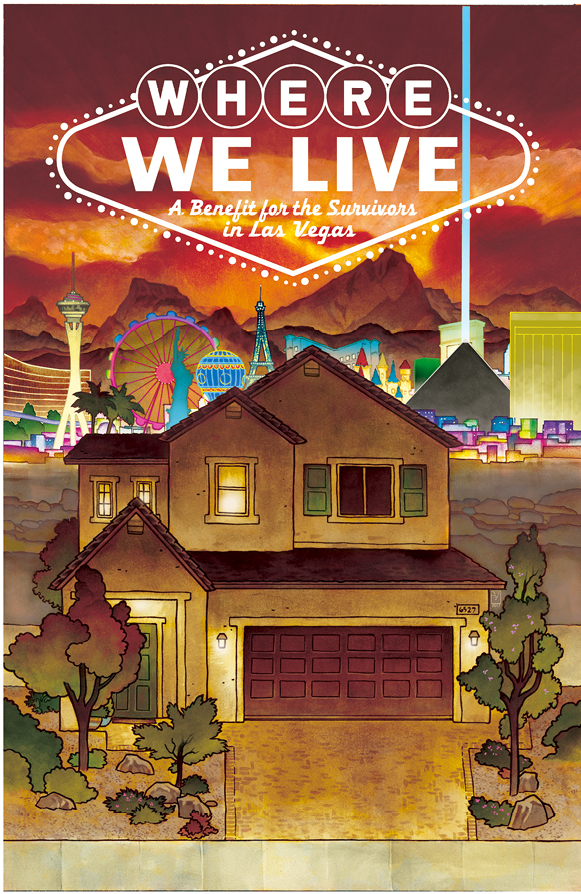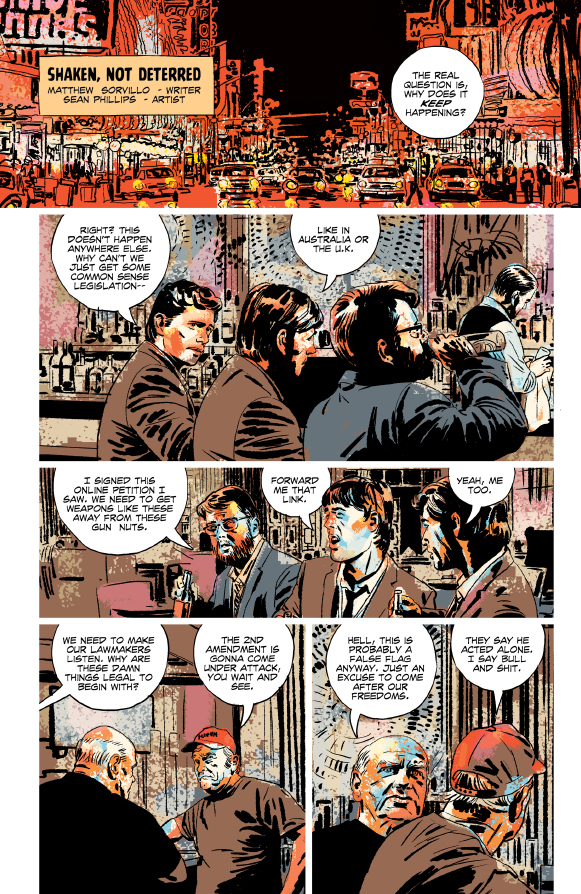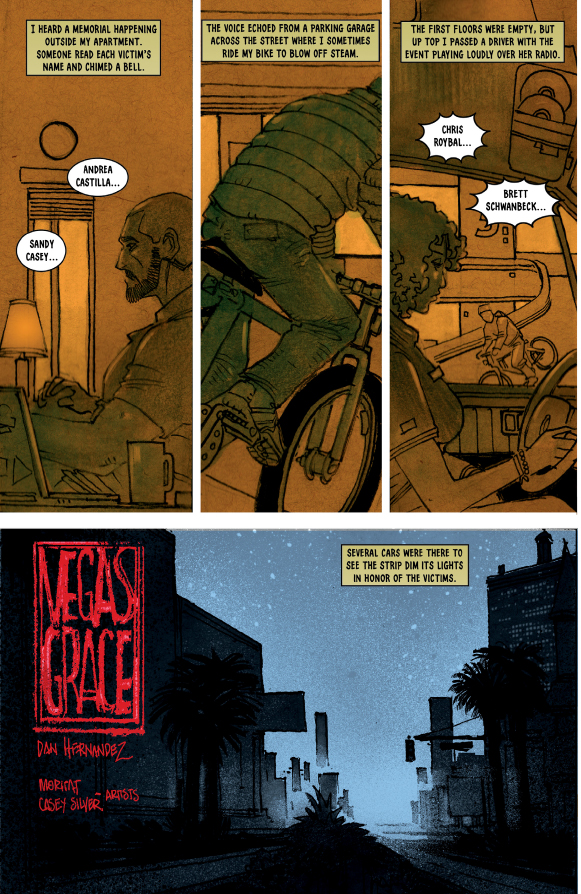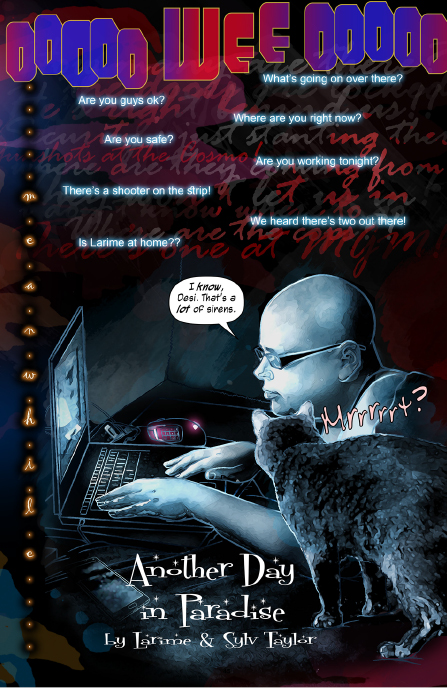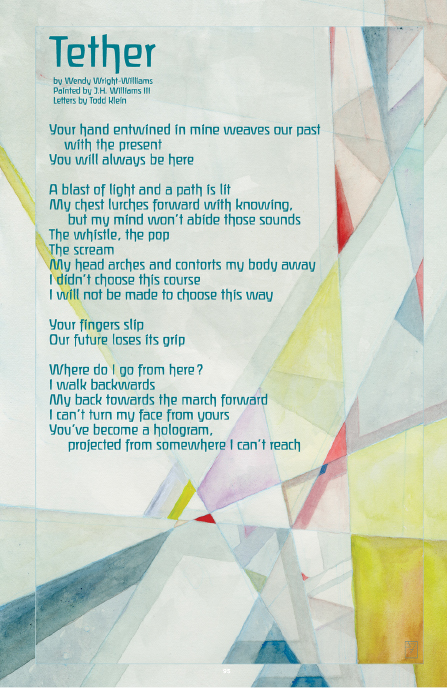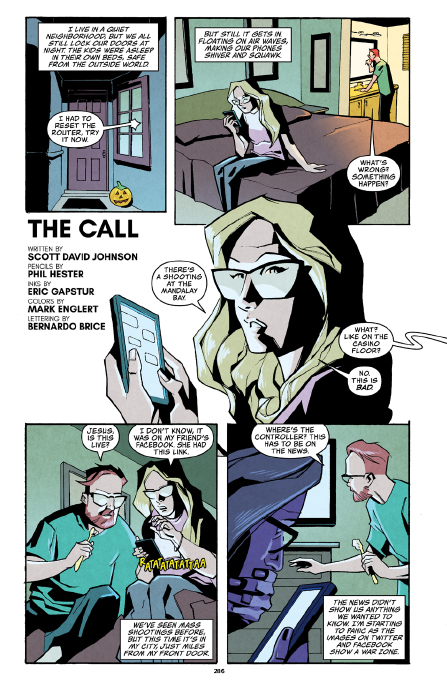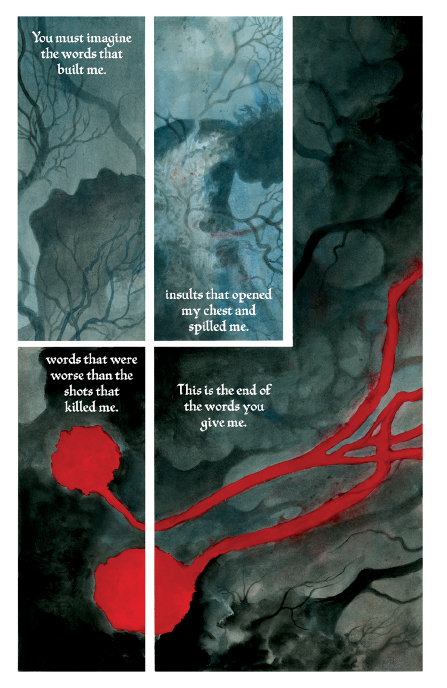Comic Relief
On May 30, Image Comics released Where We Live, a 300-page comic-book anthology benefiting the charity Route 91 Strong, which provides aid to victims of gun violence. The stories in the book reflect on the mass shooting at the Route 91 Harvest country-music festival on the Las Vegas Strip last year, in which 58 people were killed. Where We Live features contributions from some of the biggest names in the comic-book industry, including writers Neil Gaiman, Brian Michael Bendis, Mark Millar, Gail Simone, and artist J.H. Williams III, who’s also the project’s founder and curator (and a Las Vegas resident). But alongside those comics superstars are a number of local talents, whose contributions to the book add a level of connection and authenticity that can only come from having experienced the impact of the October 1 tragedy firsthand.
“I feel very honored to be a voice for my hometown, just growing up here,” says writer Jennifer Battisti, who contributed a poem (“Bristlecone in Blue”) and an essay to the collection, with illustrations by comics artists Geof Darrow (on the essay) and Williams himself (on the poem). Both pieces were written before Battisti had heard about the anthology, but when she saw the call for submissions, she was eager to participate. “I was really excited to be able to send them something, and just excited in general that somebody was putting together something like that, because there was definitely a need for that,” she says.
Battisti is an aesthetician in a Strip resort and has worked in the hospitality industry for two decades, and she saw the ripple effect from the shooting immediately. “I had to return to work the next day, which was a very bizarre and uncomfortable feeling,” she says. “There was a sense of powerlessness and kind of a feeling of ‘what’s the point?’ that very next day.” She found comfort in nature, taking a hike with a friend to see a 5,000-year-old bristlecone pine tree that’s the oldest living thing in the state. “I feel like nature has a way of reminding and restoring and healing after those types of tragedies,” she says. “I wanted to capture that and share that with other people, because it didn’t feel like anything was enduring at that moment.”
Matthew Sorvillo is another local writer with a day job on the Strip, and he too had to head to work (as a bartender at a casino pool) on the day after the shooting. In his story, a sequential piece illustrated by artist Sean Phillips, he explores the reactions of the tourists he serves on a daily basis. “The thing that I found most interesting was that a lot of people who had basically saved up all year and had come to Las Vegas to have a good time were suddenly faced with this tragedy and felt really guilty for wanting to enjoy themselves in light of what had just happened,” he explains.
“As people who work in this industry, we have to keep our opinions to ourselves, put on a happy face, even when we’re dealing with the same confusion and conflicting emotions that the guests themselves are,” Sorvillo continues. He translated those emotions into his story, brought to life by acclaimed artist Phillips. “I was just floored by the pages,” Sorvillo says of Phillips’ art. “Whatever I may have lacked in experience of writing for comics, Sean Phillips is such a professional that he just knew exactly what I was looking for without even ever speaking.”
Both Sorvillo and Battisti point to Las Vegas’ hospitality industry as a strength. “It’s possible that culturally, our community’s primary purpose, to serve, worked as an adhesive of sorts to mend the broken after the tragedy,” Battisti says. As for Sorvillo, it’s important for that tradition to continue. “We rely on people coming here and enjoying themselves,” he says, “and if that stops, that’ll do more damage to this city than any number of shootings could.”
The strength of the community is a key element in pieces from many local contributors. Writer Joshua Ellis is a self-described “cynical, nasty motherfucker,” but his essay (illustrated by in-demand comics creator Jeff Lemire) is also about the way the community rallied following the shooting. “I was incredibly heartened to see the way that the city pulled together after that, to help the people who needed help,” he says. “We were banding together in a way that I found incredibly hopeful and made my heart swell.”
Ellis was hosting an open-mic night at the Huntridge Tavern on the night of the shooting, getting updates about the unfolding events in real time. “You’re worried about everybody you know who works anywhere near or lives anywhere near the Strip,” he says. “It’s a thing that we’ve become somewhat weirdly accustomed to in America when these kinds of mass shootings happen. Because eventually it’s going to be somebody you know.” Ellis was lucky enough not to know anyone involved, but in the aftermath he still felt compelled to help, as one of the many people bringing supplies to medical personnel and first responders.
Journalist and UNLV English professor Jarret Keene also emphasizes his luck at not having any loved ones present at the concert that night, but several of his current and former students were survivors of the shooting, including one whose story he tells in his contribution to Where We Live, illustrated by Craig Cermak. “She showed up in my office about a month after the shooting,” Keene says of Aubri, whose experience he chronicles in his piece. “She seemed a bit out of it. I don’t know what made me ask the question, but I knew she was a country music fan.”
Keene learned that Aubri had been at the concert with friends, and had been struggling emotionally ever since that night. He adapted her story into a sequential piece that deals with the aftermath of tragic events, and how the young survivor overcame her trauma. “When she came to my office and I interviewed her, I was just blown away,” he says. “I guess it was six weeks after the event, and she had gone through so much and was already beginning to triumph.”
For Keene, it was important to focus on Aubri’s story without delving into contentious political issues. “I wanted to tell a human story of persevering, of surviving, of bearing witness to a horrible tragedy like this,” he says. “And then somehow, through the support of her friends, her family, her cheer squad, her students, she pushes through and manages to have a successful semester.”
Another UNLV professor, Daniel Hernandez, deals with his own trauma in his story (illustrated by Moritat). A reporter for The Guardian, Hernandez drove down to the Strip as soon as he heard about the shooting, and was talking to survivors just as they’d escaped the chaos. “When I met people who were survivors outside the concert, the trauma in their eyes and in their voices was really contagious,” he says. “I went to bed that night feeling a kind of hopelessness, a loss of faith in humanity.”
But like his fellow local writers, Hernandez eventually found hope in the community response that countered his despair. “It helped me get my faith in humanity back,” he says. “It made me realize that these are isolated events by isolated actors, and the majority of people love each other. There is still a society that we can have faith in.” As a reporter, Hernandez covered 9/11 memorials, the 2011 shooting of Rep. Gabrielle Giffords in Arizona, and the 2012 shooting at a movie theater in Aurora, Colorado. “For weeks afterward, it makes our everyday lives feel really loaded, like anything could happen,” he says, but he still manages to end his story on a note of optimism.
For all of the locals who worked on Where We Live, the book itself is part of the healing process, a way to celebrate the solidarity that Las Vegans demonstrated following the tragedy, as well as to ask tough questions about what comes next. “I think what’s special about [the book] is that it’s very thought-provoking,” Battisti says. “I think it will initiate some inconvenient and uncomfortable conversations, but very necessary conversations.”
Hernandez agrees. “What’s exciting to me is that this isn’t something that I think the comic book world has ever done before,” he says, “where they’re telling the stories of real people, regular people, and engaging with polarizing issues like gun control and gun violence.”
“I really think that the intention of the whole thing is just to get people thinking about it and get people talking about it honestly,” Sorvillo says.
“Seeing all of these A-list comic creators come together for this is also really gratifying,” Ellis adds. “These are incredibly talented, smart people doing good work.” That goes for Ellis and his fellow Vegas-based creators just as much as their more well-known peers.
Story based on an interview by Jarret Keene, art by Craig Cermak, color by Marissa Louise and lettering by Taylor Esposito.

